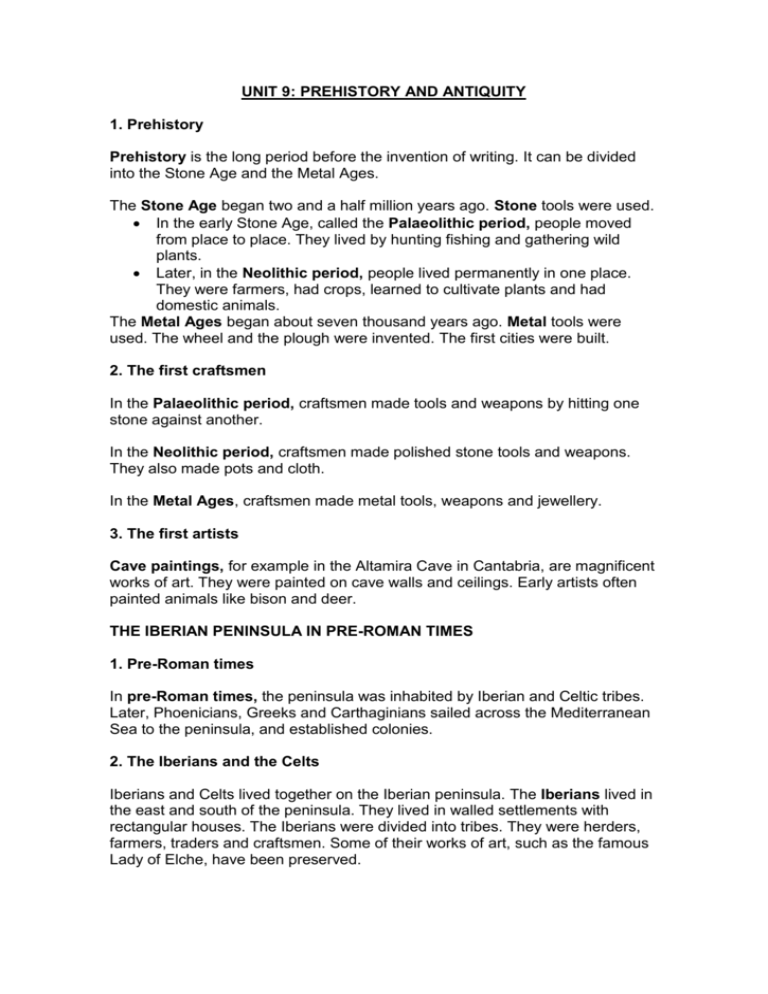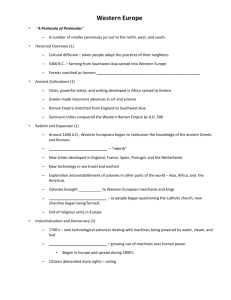PREHISTORY AND ANTIQUITY
advertisement

UNIT 9: PREHISTORY AND ANTIQUITY 1. Prehistory Prehistory is the long period before the invention of writing. It can be divided into the Stone Age and the Metal Ages. The Stone Age began two and a half million years ago. Stone tools were used. In the early Stone Age, called the Palaeolithic period, people moved from place to place. They lived by hunting fishing and gathering wild plants. Later, in the Neolithic period, people lived permanently in one place. They were farmers, had crops, learned to cultivate plants and had domestic animals. The Metal Ages began about seven thousand years ago. Metal tools were used. The wheel and the plough were invented. The first cities were built. 2. The first craftsmen In the Palaeolithic period, craftsmen made tools and weapons by hitting one stone against another. In the Neolithic period, craftsmen made polished stone tools and weapons. They also made pots and cloth. In the Metal Ages, craftsmen made metal tools, weapons and jewellery. 3. The first artists Cave paintings, for example in the Altamira Cave in Cantabria, are magnificent works of art. They were painted on cave walls and ceilings. Early artists often painted animals like bison and deer. THE IBERIAN PENINSULA IN PRE-ROMAN TIMES 1. Pre-Roman times In pre-Roman times, the peninsula was inhabited by Iberian and Celtic tribes. Later, Phoenicians, Greeks and Carthaginians sailed across the Mediterranean Sea to the peninsula, and established colonies. 2. The Iberians and the Celts Iberians and Celts lived together on the Iberian peninsula. The Iberians lived in the east and south of the peninsula. They lived in walled settlements with rectangular houses. The Iberians were divided into tribes. They were herders, farmers, traders and craftsmen. Some of their works of art, such as the famous Lady of Elche, have been preserved. The Celts lived in the centre and north of the peninsula. They lived in walled settlements with round houses. The Celts were also divided into tribes. They were herders, farmers and expert metaworkers. 3. Colonies Many ancient civilisations established colonies on the Iberian peninsula. The Phoenicians came from Asia, and settled on the southern coast. They founded the cities of Cadiz and Almunecar. The Greeks CAME from Greece, and settled on the Mediterranean coast. They founded the cities of Denia and Ampurias. The Carthaginians came from North Africa and also settled on the Mediterranean coast. They founded the city of Cartagena. ROMAN HISPANIA 1. Roman Times More than two thousand years ago, the Romans defeated the Carthaginians and conquered the Iberian Peninsula. The peninsula became part of the Roman Empire. The Romans called it Hispania. At first, the conquered tribes did not participate in Roman government. Later, they adopted Roman customs and spoke Latin, the language of the Romans. Many people from Hispania, such as philosopher Seneca, became important figures in the Roman Empire. The emperors Trajan and Hadrian were also from Hispania. Hispania was Roman for 600 years. However, after about 400 A.D. the Roman Empire weakened. Visigothic invaders entered the peninsula from northern Europe. 2. Roman Cities The Romans founded many cities in their empire. In Hispania, important Roman cities included Tarraco (now Tarragona) and Sagunto in the east, and Hispalis in the south. Roman cities were modelled on Rome, the imperial capital. They all had two main streets and a forum. The forum was a large public square where important events were celebrated. Roman cities were connected by excellent stone roads. 3. Roman Architecture The Romans built many different types of monuments. Temples were used for religious purposes. Theatres, amphitheatres and circuses were used for entertainment. Aqueducts transported water to the cities. Public bath houses used hot water.





